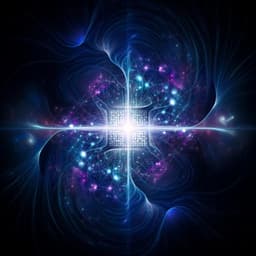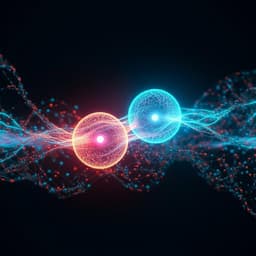
Physics
Complex quantum network models from spin clusters
R. T. C. Chepuri and I. A. Kovács
This paper introduces a groundbreaking theoretical model for complex quantum communication networks, showcasing how entangled spin clusters in interacting quantum spin systems can function as innovative communication links. Conducted by Ravi T. C. Chepuri and István A. Kovács, this research paves the way for the future of the quantum internet.
Playback language: English
Introduction
The development of a quantum internet is a significant goal with potential applications in secure communication, quantum computation, and distributed sensing. Current quantum communication networks are limited in size and typically use simple grid-like topologies. However, complex network topologies, similar to the classical internet, offer advantages such as robustness against failures. This paper addresses the need for model systems to study the impact of complex topology on quantum communication. The classical internet's success is partly due to its complex, scale-free topology, which exhibits properties like a heavy-tailed degree distribution (following a power law) and the small-world property (short average path lengths between nodes). While there are potential benefits to using similar complex topologies in quantum networks, challenges remain, such as the potential limitation of end-to-end transmission capacity due to low network density and vulnerabilities to targeted attacks. Existing quantum network proposals often avoid these complexities by using simple grid-like structures. Therefore, creating and studying model systems that reflect the intricacies of real-world complex networks is crucial for the future of the quantum internet.
Literature Review
The authors review existing literature on quantum internet architectures, focusing on quantum repeater-based systems where entangled qubit pairs form communication links between nodes. Entanglement swapping allows communication between non-adjacent nodes. The literature highlights the potential benefits of complex network topologies for quantum networks, such as increased robustness to node failures, the inherent small-world property of satellite-based networks, and the possibility of utilizing existing classical internet infrastructure. However, the challenges associated with implementing complex topologies in fiber-based quantum networks due to photonic losses and the potential impact on network capacity are also discussed. Existing quantum routing protocols mostly assume simple network structures, thus motivating the need for models that explore complex topologies.
Methodology
The authors propose a novel model for creating complex quantum networks using the ground state of the two-dimensional random transverse-field Ising model (RTIM). The RTIM, characterized by its Hamiltonian, exhibits strong disorder near its critical point, leading to the formation of distinct entangled GHZ spin clusters. These clusters are interpreted as communication links in the quantum network. The network nodes are defined as spatially localized regions of the lattice, chosen as circles of varying radii with a power-law distribution, ensuring a broad distribution of node sizes. A link is added between two nodes if they share a spin cluster that does not overlap with any other node. The strong disorder renormalization group (SDRG) method is used to efficiently determine the ground state of the RTIM and identify the spin clusters. The authors consider lattices up to size L = 4096, running simulations with multiple instances for each size. The entanglement entropy is used to quantify the entanglement between a node and the rest of the lattice, indicating the node's capacity to establish connections. The authors compare their proposed complex networks with grid-like benchmark networks and the classical internet's topology at the level of autonomous systems. Network analysis involves examining the degree distribution, average shortest path length, degree correlations, global clustering coefficient, and local clustering coefficient. The analysis also extends beyond the critical RTIM to off-critical versions and a diluted RTIM, to demonstrate the robustness and generality of the approach. They explore the impact of varying the control parameter θ and the bond percolation probability p on the resulting network size and complexity.
Key Findings
The authors' key findings demonstrate the successful generation of complex quantum networks using their proposed method. The generated networks exhibit several hallmarks of complexity:
1. **Heavy-tailed degree distribution:** The degree distribution of the quantum networks follows a power law, similar to that observed in the classical internet, contrasting with the uniform distribution seen in grid-like networks. The power-law exponent is approximately the same as the exponent used to generate the power-law distribution of node sizes, confirming the relationship between node size and degree based on the area law.
2. **Near small-world property:** Although the average shortest path length is larger than that of the classical internet, it scales much slower than in grid-like networks, indicating a small-world property.
3. **Disassortativity:** High-degree nodes tend to connect to low-degree nodes, showcasing disassortativity, a feature also present in the classical internet. This contrasts with grid-like networks which show neutral behavior.
4. **High global clustering coefficient:** The global clustering coefficient is significantly higher than in grid-like networks, indicating a greater propensity for clustering in the complex quantum networks.
5. **Hierarchical modularity:** Local clustering coefficients decay with increasing node degree, exhibiting a hierarchical network structure, similar to the classical internet. This is unlike the behavior observed in grid-like networks. The decay follows the relation C<sub>local</sub>~k<sup>−1</sup>, consistent with the hierarchical network model.
These findings are robust across different RTIM variants, including off-critical RTIM and diluted RTIM, suggesting that the approach is not limited to the critical point but applies more generally to systems exhibiting strong disorder and generating independent spin clusters. The network size is found to be maximal near, but not necessarily at, the critical point.
Discussion
The results demonstrate that it is possible to generate model quantum networks with significant complexity by exploiting the emergent entangled spin clusters in disordered quantum spin systems. The similarity between the topological properties of the generated networks and the classical internet is striking, suggesting that the proposed model captures essential features of complex network structures. The findings provide strong evidence that the emergence of complexity in quantum networks is not solely dependent on long-range connections, but can arise from the interplay of local interactions and heterogeneous node sizes. The robustness of the findings across various RTIM variants suggests that the model's applicability extends beyond the specific system studied. This work directly addresses the gap in understanding how complex network topologies may influence quantum communication protocols, suggesting promising avenues for enhancing the robustness and efficiency of future quantum internet architectures.
Conclusion
This paper introduces a novel method for creating complex model quantum networks using entangled spin clusters from the RTIM. The generated networks exhibit topological properties remarkably similar to the classical internet, including heavy-tailed degree distributions, near small-world properties, disassortativity, high clustering, and hierarchical modularity. The approach is demonstrated to be robust to variations in system parameters and generalizable to other systems exhibiting strong disorder. This work opens new avenues for research into complex network topologies in the quantum internet and motivates further experimental investigations using magnetic solids with spin clusters.
Limitations
The model makes some simplifying assumptions. The pairwise interaction between nodes is considered, discarding clusters involving more than two nodes. While this simplification allows efficient analysis, it neglects potentially important multipartite entanglement. The method of selecting node regions (using circles with a power-law distribution) may not fully capture the randomness observed in real-world network structures. The study primarily focuses on topological properties; further work could investigate the impact of network complexity on quantum communication protocols and the effects of noise and errors.
Related Publications
Explore these studies to deepen your understanding of the subject.







